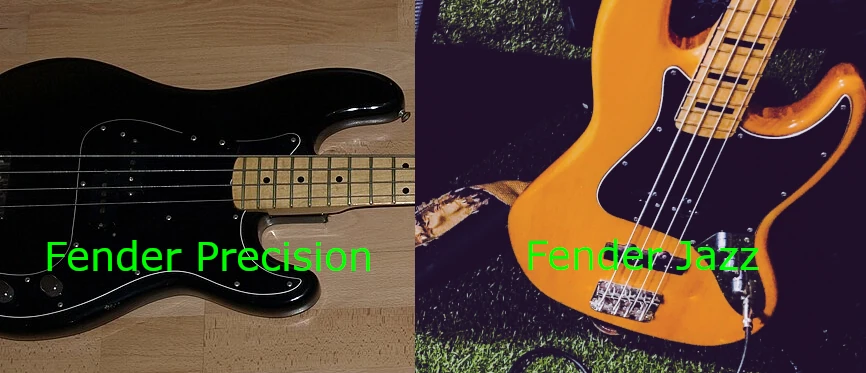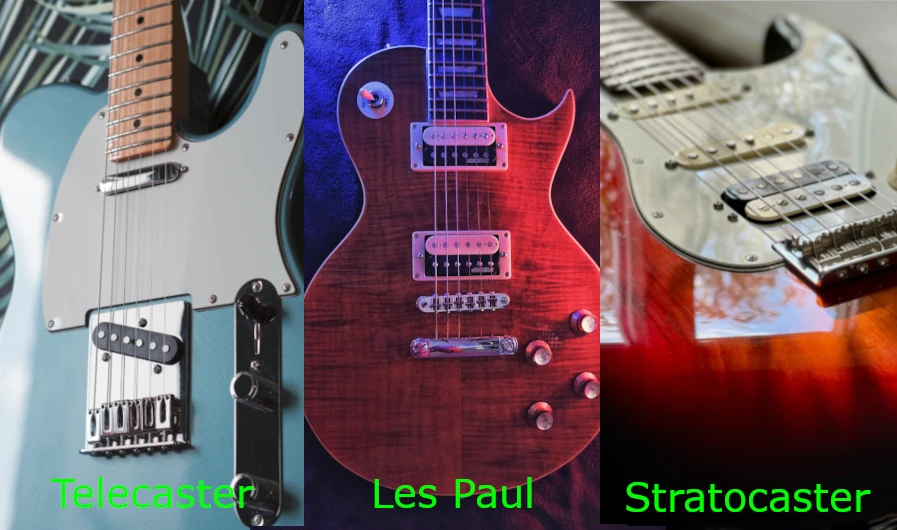During my 16 years’ of playing the bass I’ve learned that many believe it to be more expensive to be a bassist than a guitarist. However, I’ve found that this answer generally doesn’t apply to most guitarists and bassists.
Instead, my answer is as follows: On average, basses are more expensive to manufacture than guitars. However, you can find beginner and intermediate basses & guitars at all price ranges. Therefore, the difference in cost between picking up the bass or the guitar will be negligible to most people.
So in short, if you are comparing the bass and the guitar the cost is among the less important factors to consider.
With that said, this does not mean you should neglect it completley. Therefore, I’ve written this article to show you what to be mindful of when comparing prices between basses and guitars. This way, you will know how the two instruments will differ in costs when starting out as well as over the years.
Cost of entry-level Basses vs Guitars
For a decent entry-level bass or guitar, expect to pay between $150 and $400. This estimate is exactly the same for electric basses and electric guitars. For acoustic guitars, this range will be lower, and you will find lots of decent instruments in the $100 to $300 range.
To illustrate this better, here is a list of 5 entry-level guitars and basses; all of which I can vouch for. These 10 instruments all tend to fluctuate within the abovementioned price range of $150-$400. These are decent instruments that provide great value for their price and are all good picks for a beginner:
| Guitar | Cost |
| Ibanez GRX20 | $179 |
| ESP M10 | $199 |
| Jackson JS22-7 | $249 |
| Yamaha Pacifica 112V | $289 |
| Squier CV 50s Stratocaster | $349 |
| Bass | Cost |
| Squier Sonic Precision | $169 |
| Ibanez GSR180 | $177 |
| Squier Affinity P Bass PJ | $225 |
| Squier 40th Anniv P-Bass | $259 |
| Marcus Miller P5 Alder-4 | $369 |
These instrument prices are based on numbers from well-known distributors such as Thomann & Gear4Music (September 2023)
In other words, you don’t need to spend a whole lot to get started with either the bass or the guitar.
To get more specific, I find that a good price range for beginner basses is $250-$300, with the same holding true for guitars. In this range, you are less likely to find poor quality instruments. You will also avoid overpaying for an instrument that you don’t know how to take full advantage of yet.
If you want to go lower, you can also find both basses and guitars at an even lower price point. Examples of this include the Harley Benton PJ-5 bass for $129 or the Harley Benton TE-20HH guitar for 89$. These are current prices at time of writing at Thomann. If you buy second hand, you can find them even cheaper.
However, I advise against this unless you are on a very strict budget and are willing to settle for what I consider a sub-par instrument.
Either way, the bottom line is this: Guitars and basses are available at a wide price range, and beginners will notice little to no difference in cost between the two.

Manufacturing costs of Basses & Guitars
As opposed to the cost of entry-level instruments, basses and guitars differ in manufacturing cost. In general, bass guitars are more expensive to manufacture than electric guitars.
Here I’m talking about general reasons why a bass and guitar of similar quality and style will differ in price. This is on reason why some say “basses are more expensive than guitars” despite both instruments being available at a wide price-range.
In total, I’ve condensed the difference in manufacturing cost to 4 main points:
1. Size
A larger instrument requires more materials. Basses are 1.21 times longer than guitars, and thus cost more to make than guitars.
This is reflected in most of the components of the instruments, but the most noteworthy difference comes from the amount of wood required to make them.
2. Demand
Bass players are in demand, with bands commonly finding it harder to find 1 bassist than 2 guitars players.
Due to the higher popularity of the guitar, it is also cheaper and easier to mass produce them. This is because manufacturers can be sure there will be a market for the guitars. Therefore, retailers can buy them in bulk, knowing they will be sold quicker than basses.
3. Strings
Despite both sharing an E Standard tuning, basses are tuned an octave lower than guitars.
As a result, bass strings need to be significantly thicker than guitar strings to support the deeper frequency of the instrument. This means that the strings need more windings and more materials due to their thickness and length. This also increases their cost.
4. Tension
In turn, the thickness of bass strings leads to more tension in the neck of the bass. Thus, the bass needs a neck and a truss rod inside it to support the tension.
The result of this is that all basses need a base-level of quality that is higher than that of guitars for their necks to not bend out of shape.
Cost of Intermediate Basses vs Guitars
Intermediate instruments are usually of higher quality, and are less likely to be mass produced like entry-level basses and guitars are. It is common to buy these as your second instrument after you have gotten serious about improving, and have developed an idea of what type of sound you are looking for.
In the world of bass guitars, Fender introduced the bass to the consumer market in the early 50s. Since then, they have remained one of the most notable bass manufacturers in the world. Most notably, Fender’s precision and jazz basses still remain extremally popular and in-demand models to this day.
The more affordable models of these instruments generally come in the $600 to $1200 range. However, some models of the P and J bass can cost significantly more.

Fender is also big in the electric guitar space, with their Stratocaster’s and Telecaster’s being popular models. There is also the iconic Gibson Les Paul which guitarists like Jimmy Page, Slash and Eric Clapton have inspired countless young guitar players to pick up.
These guitars have a wider range of cost than guitars at approximately $500 to $2000. Thus at the intermediate stage guitars can be a lot cheaper than basses or vice versa. This is because differences in cost have a lot more to do with individual models, than whether the instrument is a 4 or a 6-string.

Why basses and guitars differ in cost
Most of these intermediate instruments have lots of different models. For example, individual models of the Les Paul differ greatly in price. You could opt for a budget Epiphone Les Paul for $150, or a signature Slash model from Gibson for $3000.
These differences comes from a range of things, such as:
- Brand – Fender and Gibson are justified in charging more than Epiphone and Squier as they produce higher quality instruments. However, this recognition in quality and name also leads to demand and trust that allows them to increase costs further. Other manufacturer’s like Rickenbacker intentionally keep demand high to keep the prices of their instruments up.
- Craftmanship – Cheap instruments are often mass-produced, whereas more expensive ones are hand-made. This leads to a massive difference in how much time, effort and skill is required to make the instrument. These factors can also leads to massive differences in cost.
- Wood type – Both the bass and the guitar mainly consists of wood. Different types of wood differ greatly in price due to its rarity, density and durability. Thus, a similar instrument made of Adler would cost significantly less than one made out of Ebony wood.
- Other materials – Any individual component could cost a lot if it is a high-end part. For example, the cost of guitar tuners could range from $10 to $150. Thus, an individual instrument only needs to consists of higher end parts in some areas before we see a notable change in it’s cost.
These are also the main reasons why more expensive basses sound better according to some, with the same holding true for guitars.
Thus, one intermediate musician might opt for a $500 instrument and the other a $1500 instrument. Who opts for which has little to do with whether they are a guitarist or a bassist. Rather, it depends on their style, preference and needs as musicians.
Surprising extra costs of Basses & Guitars
Lastly, there are some additional costs that can effect the cost of playing bass and guitar differently.
These are extra factors that musicians often don’t think about prior to choosing their instrument. Thus, being mindful of these are helpful for getting a clearer idea of how much it costs to play both instruments in the long run:
- Strings – As mentioned above, bass strings cost more than guitar strings. However, this does not necessarily make the guitar cheaper to play in the long run. This is because you could end up changing guitar strings more often. While this largely comes down to preference, it is not uncommon for guitarists to change strings 3-4 times a year, while bassists change them 1-2 times.
- Pedals & Effects – Both guitarists and bassists commonly use effects and pedals to enhance their sound. However, pedals are significantly more popular among guitar players. Combine this with common pedals costing $50-$200 and guitarist’s often buying a multitude of them, and you can quickly see why this is can add up.
- Additional instruments – Depending on what type of sound you are looking for, you might do well with just 1 bass or guitar. Personally, I tend to stick to a single bass at a time. However, some prefer having the tonal selection of multiple instruments. Depending on what camp you fall in, you could need to multiply the costs of you hobby.
Conclusion
As every musician’s journey is so different, it is also hard to estimate exactly how much you will spend as a bassist as opposed to a guitarist. What is certain though, is that you can be either on the same budget.
Theoretically, you would need to be pay slightly more for a bass that is of an identical build and identical quality as a guitar. However, this is not a scenario you will ever run into in the real world as the two instruments are produced differently.
There will be notable differences in cost if you have a preference for guitars or basses from a high-end manufacturer. You might also spend a lot more money on additional gear with either instrument, though you are more likely to do so as a guitar player.
Regardless, I would consider all of the above secondary concerns unless you are on a tight budget. Always choose what suits your style and preferences the best instead of focusing on costs. If you don’t, chances are you will be buying a new instrument within half a year anyway.

